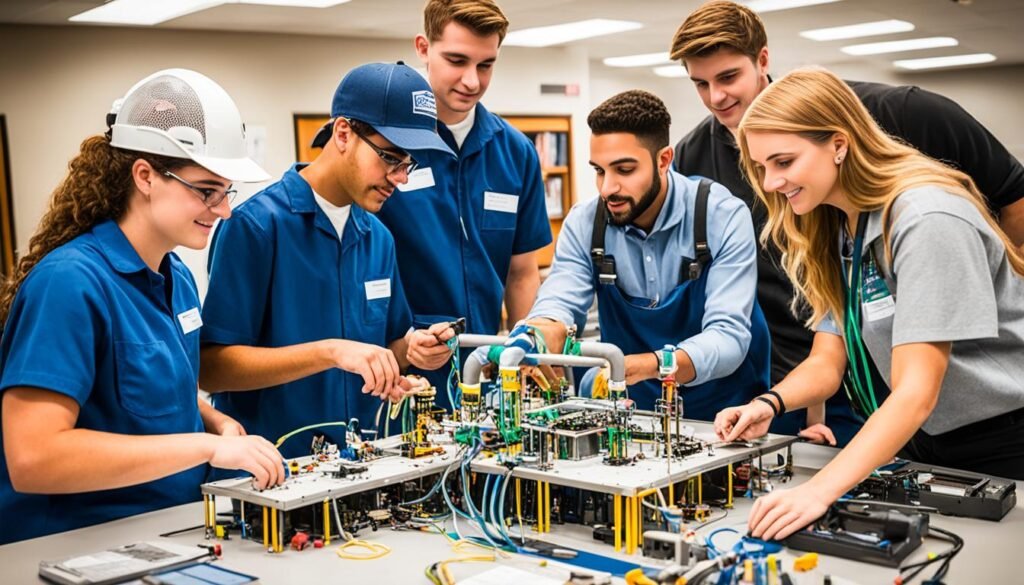Postsecondary education is essential for both personal growth and career success. Whether you choose to attend college, university, or pursue higher education in vocational fields, obtaining a postsecondary credential opens up a world of opportunities. It equips individuals with the necessary skills and knowledge to excel in their chosen profession and adapt to the ever-evolving job market.
In fact, by 2027, it is estimated that 70% of jobs in the United States will require education or training beyond high school. This highlights the increasing importance of postsecondary education in today’s competitive landscape. The Department of Education is committed to ensuring that every student has access to the education and training they need to secure rewarding careers and thrive in the workforce.
Key Takeaways:
- Postsecondary education is crucial for career success and personal growth
- Obtaining a postsecondary credential unlocks new opportunities and enhances skills
- By 2027, 70% of jobs in the US will require education or training beyond high school
- The Department of Education focuses on innovative pathways for students to earn industry-recognized credentials
- Strategies such as raising the bar for career success, dual enrollment, work-based learning, and workforce credentials are prioritized
The Problem of Limited Job Opportunities without Postsecondary Education
In today’s competitive job market, having some form of postsecondary education and training has become increasingly crucial. Most good jobs that offer a living wage require individuals to possess a postsecondary credential. Without this credential, individuals may face limited job opportunities and lower earning potential.
By obtaining a postsecondary credential, individuals can open doors to a wider range of job opportunities and increase their chances of securing well-paying and fulfilling positions. Postsecondary education and training provide individuals with the necessary knowledge, skills, and qualifications to excel in their chosen fields.
Moreover, as the landscape of work evolves, the demand for workers with postsecondary credentials continues to grow. The advancement of technology and automation has changed the skills required by employers. Many jobs now require specialized knowledge, critical thinking, problem-solving abilities, and project management skills that are typically developed through postsecondary education and training.
By increasing the number of Americans with postsecondary credentials, the country can meet the demand for skilled workers and strengthen its workforce. This not only benefits individuals by expanding their job prospects and earning potential but also contributes to the overall economic growth and prosperity of the nation.
To address the problem of limited job opportunities without postsecondary education, it is crucial to connect education and workforce systems. By establishing strong partnerships between educational institutions, employers, and industry leaders, students can be provided with clear pathways to high-quality postsecondary education and training.
These pathways can include apprenticeships, internships, vocational training programs, and other forms of experiential learning that bridge the gap between education and the labor market. By integrating education and training with real-world work experiences, individuals can develop the practical skills and knowledge needed to succeed in their chosen career paths.
Furthermore, initiatives that support lifelong learning and continuous professional development are essential. By encouraging individuals to pursue further education and training throughout their careers, they can adapt to changing job market demands and enhance their skills and qualifications.
The government, educational institutions, employers, and individuals all have a role to play in addressing the problem of limited job opportunities without postsecondary education. By working together and investing in postsecondary education and training, we can create a future where individuals have access to a wide range of job opportunities and can achieve their professional aspirations.
| Benefits of Postsecondary Education: |
|---|
| Expanded job opportunities |
| Higher earning potential |
| Enhanced knowledge and skills |
| Continued professional development |
| Improved job satisfaction |
| Increased likelihood of career advancement |
| Better positioning in the job market |
Raise the Bar: Unlocking Career Success

The Unlocking Career Success initiative is revolutionizing how high schools prepare students for future careers. By blurring the lines between elementary and secondary education, college, and careers, students can be better equipped to achieve long-term success. With a focus on education-to-employment strategies tailored to regional economic needs, the Department of Education collaborates with the White House, the Departments of Labor and Commerce, and employers to drive innovation in education and workforce development.
Through partnerships, resources, and case studies, the Unlocking Career Success initiative empowers high schools to provide students with the tools and opportunities they need to excel in their chosen fields. By facilitating career exploration and exposing students to real-world experiences, this initiative aims to bridge the gap between education and the workforce, ensuring that students are well-prepared for the demands of the modern job market.
Creating Pathways for Success
One key aspect of the Unlocking Career Success initiative is the development of innovative pathways in education and workforce development. By aligning high school curricula with the skills and competencies required for future careers, students can gain a competitive edge and set the stage for career success. These pathways emphasize not only academic achievement but also practical skills, work-based learning opportunities, and industry-recognized credentials.
“The Unlocking Career Success initiative transforms traditional education by providing students with the knowledge, skills, and connections they need to embark on successful careers.”
The initiative encourages the establishment of career-connected high schools that integrate college and career readiness into the fabric of education. These schools offer specialized programs and courses, such as apprenticeships, internships, and dual enrollment options, that enable students to earn college credits and industry certifications while still in high school. By immersing students in real-world experiences and professional environments, these career-connected high schools nurture career aspirations and foster a sense of purpose in students.
Moreover, the Unlocking Career Success initiative recognizes the importance of collaboration between educators, employers, and community partners. By forging strong partnerships, high schools can align their curriculum with industry needs, ensuring that students are prepared for the specific demands of the workforce. These collaborations also provide students with mentorship opportunities, internships, and access to cutting-edge resources and technologies, further enriching their educational experience.
Empowering Students for Career Excellence
To foster career success, the Unlocking Career Success initiative aims to empower students with the knowledge and skills they need to navigate the ever-evolving job market. Through career advising programs and resources, students can receive guidance on selecting the right educational pathways, exploring career options, and making informed decisions about their future. These resources cover a range of opportunities, including postsecondary education, job training, and entrepreneurship.
By providing students with the tools to navigate their individual career journeys, this initiative ensures that they can adapt to change, seize opportunities, and achieve their career aspirations. When students are well-informed, supported, and connected to the resources they need, they can unlock their full potential and embark on a path towards lifelong success.
| Benefits of the Unlocking Career Success Initiative: | Examples of Success: |
|---|---|
|
|
Dual Enrollment and Expanded Opportunities

Dual enrollment programs offer high school students a valuable opportunity to take college courses and earn credits towards both their high school diploma and future college degrees. This strategy not only enhances high school achievement but also promotes postsecondary enrollment and completion.
The Department of Education actively supports and encourages dual enrollment programs, recognizing their role in expanding educational opportunities for high school students. Particularly in the wake of the pandemic, providing access to dual enrollment is crucial for students who have been disproportionately affected by educational disruptions. By participating in dual enrollment, these students can regain momentum in their educational journeys and lay a strong foundation for future success.
Dual enrollment provides high school students with early exposure to college-level coursework, allowing them to experience the rigors and expectations of higher education. This early exposure not only helps students develop essential academic skills but also cultivates a sense of confidence and preparedness for the challenges they may face in college and beyond.
By earning college credits while still in high school, students can enter postsecondary education with a head start, potentially reducing the time and cost required to complete a college degree. Additionally, the credits earned through dual enrollment can be transferred to other colleges and universities, providing students with flexibility and opportunities to explore different academic paths.
Furthermore, dual enrollment programs promote workforce development by equipping students with the knowledge and skills that are in demand in today’s job market. Through college-level courses, students can gain invaluable insights into various fields of study and career paths, enabling them to make more informed decisions about their future educational and career choices.
High school students who participate in dual enrollment programs not only reap the benefits of expanding their academic horizons but also develop essential time-management, critical thinking, and problem-solving skills. These skills are essential for success in college and the workforce, preparing students for the challenges and opportunities they will encounter in their future endeavors.
Dual enrollment programs provide a bridge between high school and college, offering high school students a unique and valuable opportunity to earn college credits while still pursuing their secondary education. Through expanded access to dual enrollment, the Department of Education is committed to empowering high school students for the future.
Benefits of Dual Enrollment:
- Increased high school achievement
- Promotion of postsecondary enrollment and completion
- Early exposure to college-level coursework
- Opportunity to earn college credits while in high school
- Flexibility to explore different academic paths
- Enhanced workforce readiness and career exploration
- Development of essential skills for college and beyond
Work-Based Learning for Real-World Applications

Work-based learning programs bridge the gap between academic learning and its real-world applications, providing students with valuable hands-on experiences. These programs expose students to various career fields, allowing them to explore different industries and gain practical skills that are essential for success in the labor market.
Work-based learning programs offer students the opportunity to develop the skills needed to thrive in their chosen career fields. Through internships, apprenticeships, and on-the-job training, students can gain invaluable insights and apply their knowledge in real-world settings. This enhances their academic learning by providing practical context, deepening their understanding of concepts, and fostering critical thinking skills.
By participating in work-based learning initiatives, students not only acquire academic knowledge but also establish connections with professionals in their fields of interest. These connections open doors to mentorship, guidance, and future employment opportunities. Work-based learning also generates income for students, allowing them to develop financial independence and establish future earning potential.
The Department of Education recognizes the significance of work-based learning and aims to expand its accessibility. By fostering partnerships between educational institutions and businesses, the department promotes the integration of work-based learning programs into curriculum development, ensuring that students can develop the skills required by today’s dynamic job market.
Benefits of Work-Based Learning:
- Provides practical, real-life experiences for students
- Enhances academic learning by applying knowledge in professional settings
- Builds crucial skills for success in career fields
- Establishes connections with professionals and potential mentors
- Generates income and future earning potential
Work-based learning programs play a vital role in preparing students for their future careers. By integrating academic learning with practical experiences, students gain a competitive edge in pursuing their desired career paths and contribute to a skilled and capable workforce.
Workforce Credentials for Labor Market Success

Education programs that provide the opportunity to earn industry-recognized workforce credentials play a pivotal role in boosting career prospects and ensuring success in the labor market. With changing demands and evolving industries, it is crucial for individuals to acquire the necessary skills and knowledge to excel in their chosen fields. By obtaining reputable and sought-after workforce credentials, graduates gain a competitive edge and increase their chances of securing rewarding employment.
The Department of Education recognizes the significance of workforce credentials and actively collaborates with states and districts to identify valuable credentials that align with labor market needs. By doing so, they aim to expand opportunities for students to earn these credentials while simultaneously removing barriers to credential attainment.
“It’s not just about acquiring a degree; it’s about acquiring the right skills and credentials that employers value in today’s labor market.”
Aligning education with the needs of the labor market ensures that individuals are equipped with the skills and knowledge required for career advancement. Workforce credentials validate an individual’s expertise and serve as a benchmark for employers, indicating that they possess the necessary qualifications to thrive in their chosen profession.
Obtaining workforce credentials can lead to a multitude of career opportunities:
- Specialized certifications, such as IT certifications or project management credentials, can open doors to high-demand fields and lucrative positions.
- Industry-recognized healthcare certifications like nursing licenses or medical coding credentials offer pathways for advancement and specialization in the healthcare sector.
- Skilled trade certifications can lead to sustainable careers in fields like plumbing, electrician work, or construction.
Breaking down barriers through workforce credentials
By placing an emphasis on workforce credentials, individuals from all walks of life and educational backgrounds can access career advancement opportunities. Workforce credentials provide a way for individuals to showcase their skills and knowledge without necessarily pursuing traditional academic pathways. This inclusive approach encourages individuals to pursue their career goals and gain recognition for their expertise, regardless of their educational history.
Through close collaboration with employers and industry experts, the Department of Education helps bridge the gap between education and the labor market. By aligning educational programs with the needs of employers, they ensure that graduates possess the skills and credentials that are in demand.
Ultimately, workforce credentials serve as a valuable tool for individuals to navigate the complexities of the modern labor market and unlock their full career potential. By earning these credentials, individuals can advance their careers, secure employment in competitive industries, and continually evolve and remain relevant in an ever-changing professional landscape.
Career Advising and Navigation for Success

Career advising and navigation programs play a vital role in guiding students towards their desired paths of success. These programs provide valuable information and resources to students, assisting them in navigating the complex landscape of career exploration, college options, and job training.
Through career advising, students gain insight into various career paths, helping them make informed decisions about their future. They receive guidance on identifying their passions, strengths, and interests, empowering them to choose college majors or job training programs that align with their goals.
Additionally, career advising equips students with knowledge about the diverse opportunities available in the job market. By understanding the current trends and demands, students can make strategic choices in their educational pursuits, ensuring their skills are aligned with in-demand industries.
The Department of Education recognizes the significance of career advising in shaping students’ futures. They are dedicated to expanding access to these programs, ensuring that all students, regardless of their backgrounds or circumstances, have the support they need to make informed decisions about their careers.
In line with promoting inclusive education, the Department of Education also emphasizes the importance of providing support for students with disabilities. By creating inclusive career advising programs, these students can receive the necessary guidance to overcome obstacles and achieve their career goals.
By investing in career advising and navigation programs, students are better prepared to enter college or job training programs with clear goals and a roadmap to success. These programs empower them to make deliberate choices, ensuring that they maximize their potential and seize the opportunities that await them in their chosen fields.
The Benefits of Career Advising and Navigation Programs
Here are some of the key benefits students can gain from participating in career advising and navigation programs:
- Exploration of Career Options: Students can explore a wide range of career options and gain insights into different industries, helping them make informed decisions about their future.
- Knowledge of College Options: Through career advising, students gain information about various colleges and universities, enabling them to select institutions that offer programs aligned with their career interests.
- Financial Aid Guidance: Career advising programs provide information about financial aid options, scholarships, and grants, assisting students in navigating the often complex process of financing their education.
- Transition Support: These programs offer support during the transition from high school to college or job training programs, ensuring a smooth adjustment and minimizing any potential challenges.
- Industry Insights: Career advisors provide students with valuable insights into the labor market, highlighting emerging industries, in-demand skills, and potential job opportunities.
- Networking Opportunities: Students can connect with professionals in their desired fields through career advising programs, building valuable networks that can facilitate future job placements and mentorship.
By encompassing all these benefits, career advising and navigation programs support students in achieving their academic, career, and personal goals. These programs serve as indispensable resources that unlock the potential of every student, ensuring they are well-equipped to succeed in college, job training, and beyond.
Testimonials from Students
“The career advising program at my high school helped me discover my passion for computer science. The guidance I received not only helped me choose the right college but also paved the way for internships and job offers in the field.”
– Jenna Thompson
“Navigating the college application process can be overwhelming, but the career advising program made it much easier. I received personalized guidance that aligned my aspirations with the right college, setting me on a path to my dream career in healthcare.”
– Miguel Rodriguez
| Key Takeaways |
|---|
| • Career advising and navigation programs guide students in making informed decisions about their future. |
| • These programs provide insights into career options, college choices, and financial aid options. |
| • The Department of Education strives to expand access to career advising programs for all students. |
| • Support for students with disabilities ensures an inclusive and accessible educational experience. |
| • Career advising programs offer networking opportunities and industry insights. |
The Benefits of Cosmetology as Postsecondary Education

While traditional academic pathways are often emphasized, vocational fields like cosmetology offer rewarding postsecondary education options. Cosmetology programs provide comprehensive training in hairstyling, skincare, makeup artistry, and salon management. Graduates can pursue various career paths within the beauty industry, showcasing their creativity and artistic abilities. The demand for skilled cosmetologists remains high, providing job satisfaction and the opportunity to positively impact clients’ confidence and self-esteem.
Choosing cosmetology as a postsecondary education path opens up a world of possibilities in the vocational fields. Whether working in a high-end salon, owning a beauty business, or becoming a freelance artist, cosmetologists have the flexibility to shape their careers according to their interests and aspirations.
One of the key advantages of pursuing cosmetology is the hands-on training students receive. Cosmetology programs often include practical experience, allowing students to apply their knowledge in real salon settings. This practical experience not only enhances technical skills but also prepares students to handle diverse clienteles, develop strong communication skills, and understand the intricacies of running a successful salon.
Furthermore, the beauty industry is constantly evolving, offering cosmetologists the opportunity to stay up-to-date with the latest trends, techniques, and technologies. Continuing education and professional development are highly valued in the cosmetology field, ensuring that graduates remain competitive and adaptable throughout their careers.
In addition to job satisfaction and creative expression, pursuing cosmetology as a postsecondary education option can lead to financial stability. Skilled cosmetologists have the potential to earn a competitive salary, especially when they establish a loyal clientele and build a strong reputation.
“Cosmetology is not just about making people look good on the outside; it’s about helping them feel confident and beautiful on the inside too.”
Moreover, the impact of cosmetologists extends beyond the physical transformation. They have the privilege to uplift clients’ spirits, boost self-esteem, and create lasting connections. The ability to positively impact someone’s life is a rewarding aspect of a career in cosmetology.
Unlock Your Potential in the Beauty Industry
If you have a passion for creativity, a desire to help others, and an interest in the beauty industry, cosmetology can offer a fulfilling career path. By pursuing cosmetology as a postsecondary education option, you can unlock your potential and embark on a journey that combines artistry, entrepreneurship, and personal growth.
Whether you dream of becoming a hairstylist, makeup artist, esthetician, or salon owner, cosmetology provides the foundation for success in the vibrant world of beauty. It’s an opportunity to turn your passion into a profession and make a lasting impact on people’s lives.
Expanding Access to Education through Technology

Advancements in technology have revolutionized education, allowing individuals to access a wealth of knowledge and opportunities through online learning platforms. These platforms have transformed the way we learn, offering a wide range of courses, certifications, and degree programs, all accessible from anywhere with an internet connection.
Online learning has democratized education, breaking down barriers that may have traditionally limited access to postsecondary opportunities. Individuals who may face factors such as distance, finances, or other constraints can now pursue their educational goals without the need for physical proximity to a traditional learning institution.
The internet has opened up a world of education to learners of all backgrounds, providing them with the flexibility to study at their own pace and on their own schedule.
Through online learning, students can explore diverse subjects, acquire new skills, and gain knowledge in a variety of fields. Additionally, the flexibility offered by technology-enabled education allows individuals to balance their learning with other commitments, such as work or family responsibilities.
Accessible Education for All
One of the key advantages of online learning is the accessibility it offers individuals with disabilities or other specific needs. By leveraging technology, educational content can be made more inclusive and adaptable, catering to diverse learning styles and requirements. Online platforms can provide features such as closed captioning, text-to-speech functionality, and other assistive technologies to ensure that all learners can fully engage with the material.
Furthermore, online learning eliminates geographical limitations, providing equal educational opportunities to individuals in rural or underserved areas. Whether someone resides in a remote village or a bustling city, they can access the same quality education as their urban counterparts, breaking down educational disparities that may exist between different regions of the country.
By embracing the potential of technology in education, we can foster a more inclusive and accessible learning environment, empowering learners of all backgrounds to pursue their educational aspirations.
Grants and Resources for Postsecondary Education

The Department of Education recognizes the importance of providing grants and resources to support postsecondary education initiatives. These programs aim to ensure that all students have the necessary funding and support to pursue their educational and career goals. One such initiative is the Career-Connected High Schools program, which fosters partnerships between high schools, colleges, and employers.
Career-Connected High Schools prioritize a well-rounded education that blends classroom instruction with real-world experiences. By emphasizing dual enrollment, students can earn college credits while still in high school, giving them a head start on their postsecondary education. This program also encourages the pursuit of workforce credentials, equipping students with the skills and certifications needed for success in their chosen career paths.
In addition, Career-Connected High Schools offer work-based learning opportunities, allowing students to gain practical experience in their desired fields. This hands-on approach enhances their understanding of specific industries and helps them develop critical skills that will be valuable in the workforce. Furthermore, career guidance resources are provided to help students explore various career options and make informed decisions about their future.
Through grants and federal resources, the Department of Education aims to bridge the gap between high school, college, and career, giving students the best possible chances for success. These initiatives not only provide financial assistance but also create comprehensive pathways that align education with the needs of the labor market. By connecting students with relevant resources, they can unlock their full potential and achieve their career aspirations.
Benefits of Career-Connected High Schools
There are numerous benefits to implementing Career-Connected High Schools as part of the postsecondary education system. Below are some key advantages:
- Enhanced college readiness: By participating in dual enrollment programs and earning college credits, students are better prepared for the academic rigors of higher education.
- Improved career prospects: Work-based learning experiences provide students with valuable skills and connections in their desired industries, increasing their employability.
- Increased graduation rates: Career-Connected High Schools can boost high school graduation rates by offering engaging, relevant coursework and providing personalized support.
- Alignment with industry needs: These programs are designed in collaboration with employers, ensuring that students are equipped with the skills required in the current job market.
- Expanded networks: Through partnerships between high schools, colleges, and employers, students can build professional networks that will benefit them throughout their careers.
By investing in Career-Connected High Schools and providing the necessary grants and resources, the Department of Education is helping to create a more robust and comprehensive postsecondary education system. These initiatives empower students to pursue their passions, gain valuable skills, and achieve success in their future careers.
| Program | Description | Benefits |
|---|---|---|
| Career-Connected High Schools |
A partnership program that blends high school, college, and career experiences through dual enrollment, work-based learning, and career guidance. |
|
Grants and resources provided by the Department of Education play a vital role in supporting postsecondary education initiatives like Career-Connected High Schools. With a focus on dual enrollment, workforce credentials, work-based learning, and career guidance, these programs unlock opportunities for students to excel in their future careers. By fostering collaboration between high schools, colleges, and employers, the Department of Education is paving the way for a more connected and successful education system.
Also Read : Why Is Education Important For Everyone?
Conclusion
Postsecondary education is an essential stepping stone for personal and professional development. It not only provides individuals with enhanced job opportunities, but also facilitates skill development, expands horizons, and fosters social growth. Whether one chooses to pursue a traditional academic degree or a vocational path like cosmetology, investing in postsecondary education is an investment in oneself that lays the foundation for a brighter future.
By unlocking the potential of postsecondary education, individuals can unlock their own potential and embark on a transformative journey towards success. The journey may involve acquiring specialized knowledge, honing critical thinking abilities, and developing practical skills that align with the demands of today’s ever-evolving job market. Moreover, postsecondary education offers the opportunity to connect with diverse communities, gain cultural competence, and cultivate valuable networks that can open doors to new prospects.
Ultimately, embracing postsecondary education leads to personal growth and empowers individuals to pursue fulfilling careers that align with their passions and potentials. It equips them with the tools needed to navigate the complexities of the professional world and make meaningful contributions to their chosen fields. With the intrinsic value of education as a catalyst for personal and professional development, striving for postsecondary education is a powerful step towards achieving long-term success and realizing one’s full potential.
FAQs
Q: What is postsecondary education?
A: Postsecondary education refers to any education beyond high school, including programs offered by universities, colleges, community colleges, trade schools, and vocational schools.
Q: Why is postsecondary education important?
A: Postsecondary education can lead to higher earnings, better job opportunities, and personal growth. It is essential in today’s competitive job market.
Q: How can I become a postsecondary administrator?
A: To become a postsecondary administrator, you typically need a master’s degree in higher education administration or a related field. Relevant work experience is also important.
Q: What is accreditation in higher education?
A: Accreditation is a process in which higher education institutions are evaluated to ensure they meet certain standards of quality and are providing a reputable education.
Q: What are some statistics related to postsecondary education?
A: According to the National Center for Education Statistics (NCES), postsecondary students are expected to reach 23.1 million by May 2022. By 2030, the number is projected to increase to over 25 million.
Q: What are the differences between private and public institutions in higher education?
A: Private institutions are typically funded by tuition, donations, and endowments, while public institutions receive funding from the government. Private institutions may have higher tuition costs but may offer more financial aid.
Q: How does postsecondary education contribute to a nation’s development?
A: Graduates with postsecondary education are more likely to contribute positively to the economy, innovation, and social development of a nation. It plays a vital role in addressing societal challenges and advancing progress.
Source Links
- https://www.ed.gov/raisethebar/postsecondary-pathways
- https://standtogether.org/news/the-future-of-postsecondary-education-and-ideas-for-reform/
- https://www.tspabattlecreek.com/blog/unlocking-the-door-to-your-future-understanding-post-secondary-education/




